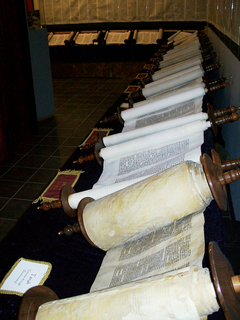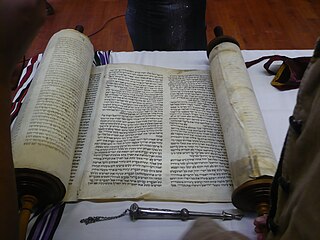Related Research Articles

The Bible is a collection of religious texts or scriptures sacred to Christians, Jews, Samaritans, Rastafari and others. It appears in the form of an anthology, a compilation of texts of a variety of forms that are all linked by the belief that they are collectively revelations of God. These texts include theologically-focused historical accounts, hymns, prayers, proverbs, parables, didactic letters, poetry, and prophecies. Believers also generally consider the Bible to be a product of divine inspiration.

The Mishnah or Mishna is the first major written collection of the Jewish oral traditions known as the Oral Torah. It is also the first major work of rabbinic literature. The Mishnah was redacted by Judah ha-Nasi at the beginning of the third century CE in a time when, according to the Talmud, the persecution of the Jews and the passage of time raised the possibility that the details of the oral traditions of the Pharisees from the Second Temple period would be forgotten. Most of the Mishnah is written in Mishnaic Hebrew, while some parts are Aramaic.

Torah has a range of meanings. It can most specifically mean the first five books of the Hebrew Bible. This is commonly known as the Written Torah. It can also mean the continued narrative from all the 24 books, from the Book of Genesis to the end of the Tanakh (Chronicles). If in bound book form, it is called Chumash, and is usually printed with the rabbinic commentaries. If meant for liturgic purposes, it takes the form of a Torah scroll, which contains strictly the five books of Moses.

The Hebrew Bible or Tanakh, is the canonical collection of Hebrew scriptures, including the Torah. These texts are almost exclusively in Biblical Hebrew, with a few passages in Biblical Aramaic. The form of this text that is authoritative for Rabbinic Judaism is known as the Masoretic Text (MT) and consists of 24 books, and is sorted and numbered using Perek and pasokim. The contents of the Hebrew Bible also composes the Christian Old Testament, in which the same material is essentially divided into 39 books. Catholic Bibles and Eastern / Greek Orthodox Bibles contain additional materials in their testaments, derived from the Septuagint and other sources.

The Masoretic Text is the authoritative Hebrew and Aramaic text of the 24 books of the Tanakh in Rabbinic Judaism. The Masoretic Text defines the Jewish canon and its precise letter-text, with its vocalization and accentuation known as the masorah. It was primarily copied, edited and distributed by a group of Jews known as the Masoretes between the 7th and 10th centuries of the Common Era (CE).

The Samaritan Pentateuch, also known as the Samaritan Torah, is a text of the first five books of the Hebrew Bible, written in the Samaritan alphabet and used as scripture by the Samaritans. It constitutes their entire biblical canon.

Ketuvim is the third and final section of the Tanakh, after Torah (instruction) and Nevi'im (prophets). In English translations of the Hebrew Bible, this section is usually titled "Writings" or "Hagiographa".

Exegesis is a critical explanation or interpretation of a text, especially a religious text. Traditionally the term was used primarily for work with the Bible. In modern usage, biblical exegesis is used to distinguish it from other critical text explanation.

Genesis Rabbah is a religious text from Judaism's classical period, probably written between 300 and 500 CE with some later additions. It is a midrash comprising a collection of ancient rabbinical homiletical interpretations of the Book of Genesis.
Hebrew cantillation is the manner of chanting ritual readings from the Hebrew Bible in synagogue services. The chants are written and notated in accordance with the special signs or marks printed in the Masoretic Text of the Bible, to complement the letters and vowel points.

It is a custom among religious Jewish communities for a weekly Torah portion, to be read during Jewish prayer services on Monday, Thursday and Saturday. The full name, Parashat HaShavua, is popularly abbreviated to parashah, and is also known as a Sidra or Sedra.

The Bible is a compilation of many shorter books written at different times by a variety of authors, and later assembled into the biblical canon. Since the early 13th century, most copies and editions of the Bible present all but the shortest of these books with divisions into chapters, generally a page or so in length. Since the mid-16th century editors have further subdivided each chapter into verses – each consisting of a few short lines or sentences. Esther 8:9 is the longest verse in the Bible. Sometimes a sentence spans more than one verse, as in the case of Ephesians 2:8–9, and sometimes there is more than one sentence in a single verse, as in the case of Genesis 1:2.
Torah reading is a Jewish religious tradition that involves the public reading of a set of passages from a Torah scroll. The term often refers to the entire ceremony of removing the scroll from the Torah ark, chanting the appropriate excerpt with special cantillation (trope), and returning the scroll(s) to the ark. It is also commonly called "laining".
Seder is a Hebrew word meaning "order" or "sequence" may also refer to:

Qere and Ketiv, from the Aramaic qere or q're, קְרֵי and ketiv, or ketib, kethib, kethibh, kethiv, כְּתִיב, also known as "keri uchesiv" or "keri uchetiv," refers to a system for marking differences between what is written in the consonantal text of the Hebrew Bible, as preserved by scribal tradition, and what is read. In such situations, the Qere is the technical orthographic device used to indicate the pronunciation of the words in the Masoretic text of the Hebrew language scriptures (Tanakh), while the Ketiv indicates their written form, as inherited from tradition.

Masekhet Soferim "The Tractate of the Scribes" is a non-canonical Talmudic tractate dealing especially with the rules relating to the preparation of holy books, as well as with the laws of Torah reading. One of the minor tractates, it is generally thought to have originated in eighth-century Land of Israel. Being of late and uncertain date, it is now generally printed as Talmudic addenda.

The Triennial cycle of Torah reading may refer either
Biblical Hebrew orthography refers to the various systems which have been used to write the Biblical Hebrew language. Biblical Hebrew has been written in a number of different writing systems over time, and in those systems its spelling and punctuation have also undergone changes.

The Damascus Pentateuch is a 10th-century Hebrew Bible codex, consisting of the almost complete Pentateuch, the Five Books of Moses. The codex was copied by an unknown scribe, replete with Masoretic annotations. The manuscript is defective in its beginning, as it starts with Genesis 9:26, and Exodus 18:1–23 is also missing. In 1975 it was acquired by the Jewish National and University Library, Jerusalem, which in 2008 changed its name to "National Library of Israel". The codex was published in a large, two-volume facsimile edition in 1978. It should not be confused with another manuscript, the Damascus Crown of medieval Spanish origin, containing 24 canonical books.
In orthography, a plene scriptum is a word containing an additional letter, usually one which is superfluous, not normally written in such words, nor needed for the proper comprehension of the word. Today, the term applies mostly to sacred scripture. Examples of plene scripta appear frequently in classical Hebrew texts, and copyists are obliged to copy them unchanged, to ensure that biblical or other sacred texts are written with universal conformity. The expression plene scriptum, sometimes simply described in Hebrew as מלא, is often used in contrast with defective scriptum, the latter implying a word in which a letter that is normally present has been omitted. Together, plene and defective scripta are sometimes described using the Hebrew phrase "haser ve yater".
References
- ↑ Moses, Lionel E. "Is there an Authentic Triennial Cycle of Torah Readings?" p. 334, 1987
- ↑ Tractate Megillah 29b